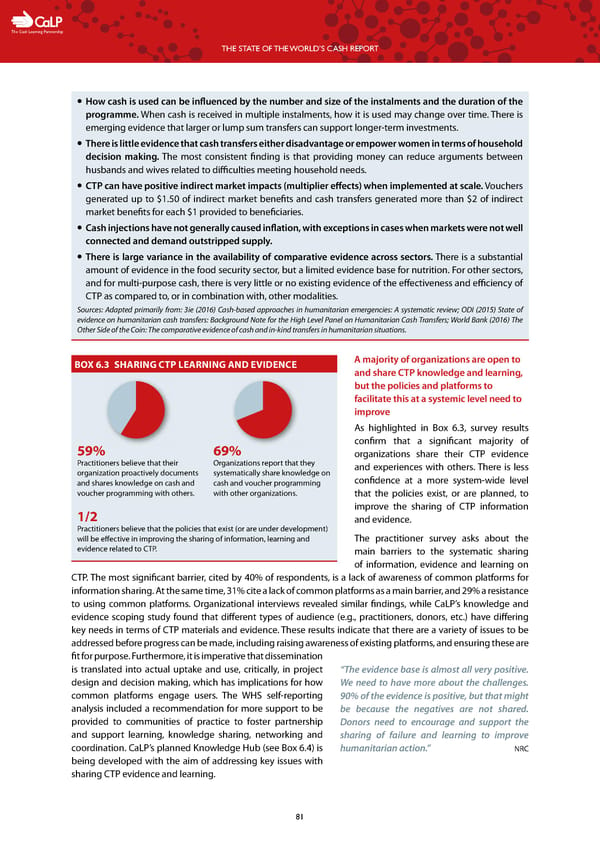C The Cash Learning Partnership THE STATE OF THE WORLD’S CASH REPORT — How cash is used can be influenced by the number and size of the instalments and the duration of the programme. When cash is received in multiple instalments, how it is used may change over time. There is emerging evidence that larger or lump sum transfers can support longer-term investments. — There is little evidence that cash transfers either disadvantage or empower women in terms of household decision making. The most consistent finding is that providing money can reduce arguments between husbands and wives related to difficulties meeting household needs. — CTP can have positive indirect market impacts (multiplier effects) when implemented at scale. Vouchers generated up to $1.50 of indirect market benefits and cash transfers generated more than $2 of indirect market benefits for each $1 provided to beneficiaries. — Cash injections have not generally caused inflation, with exceptions in cases when markets were not well connected and demand outstripped supply. — There is large variance in the availability of comparative evidence across sectors. There is a substantial amount of evidence in the food security sector, but a limited evidence base for nutrition. For other sectors, and for multi-purpose cash, there is very little or no existing evidence of the effectiveness and efficiency of CTP as compared to, or in combination with, other modalities. Sources: Adapted primarily from: 3ie (2016) Cash-based approaches in humanitarian emergencies: A systematic review; ODI (2015) State of evidence on humanitarian cash transfers: Background Note for the High Level Panel on Humanitarian Cash Transfers; World Bank (2016) The Other Side of the Coin: The comparative evidence of cash and in-kind transfers in humanitarian situations. BOX 6.3 SHARING CTP LEARNING AND EVIDENCE A majority of organizations are open to and share CTP knowledge and learning, but the policies and platforms to facilitate this at a systemic level need to improve As highlighted in Box 6.3, survey results 59% 69% confirm that a significant majority of organizations share their CTP evidence Practitioners believe that their Organizations report that they and experiences with others. There is less organization proactively documents systematically share knowledge on confidence at a more system-wide level and shares knowledge on cash and cash and voucher programming voucher programming with others. with other organizations. that the policies exist, or are planned, to 1/2 improve the sharing of CTP information and evidence. Practitioners believe that the policies that exist (or are under development) will be effective in improving the sharing of information, learning and The practitioner survey asks about the evidence related to CTP. main barriers to the systematic sharing of information, evidence and learning on CTP. The most significant barrier, cited by 40% of respondents, is a lack of awareness of common platforms for information sharing. At the same time, 31% cite a lack of common platforms as a main barrier, and 29% a resistance to using common platforms. Organizational interviews revealed similar findings, while CaLP’s knowledge and evidence scoping study found that different types of audience (e.g., practitioners, donors, etc.) have differing key needs in terms of CTP materials and evidence. These results indicate that there are a variety of issues to be addressed before progress can be made, including raising awareness of existing platforms, and ensuring these are fit for purpose. Furthermore, it is imperative that dissemination is translated into actual uptake and use, critically, in project “The evidence base is almost all very positive. design and decision making, which has implications for how We need to have more about the challenges. common platforms engage users. The WHS self-reporting 90% of the evidence is positive, but that might analysis included a recommendation for more support to be be because the negatives are not shared. provided to communities of practice to foster partnership Donors need to encourage and support the and support learning, knowledge sharing, networking and sharing of failure and learning to improve coordination. CaLP’s planned Knowledge Hub (see Box 6.4) is humanitarian action.” NRC being developed with the aim of addressing key issues with sharing CTP evidence and learning. 81
 The State of the World's Cash | Full Report Page 82 Page 84
The State of the World's Cash | Full Report Page 82 Page 84